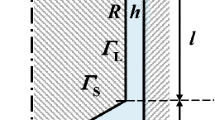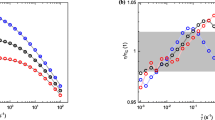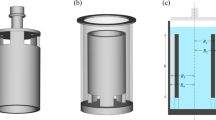Abstract
Neglect of end effects in Couette rotational viscometry introduces a 10–30% error in the estimate of shear stress at the spindle surface. Actual deviations depend on the shear-thinning level of a given sample. We tackle the end effect for the standard sensor Z40 DIN according to the ISO 3219 by solving the related 2D boundary-value problem for a class of shear-thinning viscosity functions. The pseudosimilarity method of treating the primary data leaves an error of about 0.5% in shear stresses. Further reduction in the errors needs a full numerical simulation for each point of the primary data based on a suitable wide-range representation of the viscosity function. To support a high accuracy of torque calibrations, the effect of inertia on torque for Newtonian liquids in standard sensor Z40 DIN at Re < 500 is calculated using the FLUENT 6.2 commercial software.





Similar content being viewed by others
References
Ancey C (2005) Solving the Couette inverse problem by using a wavelet-vaguelette decomposition. J Rheol 49:441–460
Astarita G (1990) The engineering reality of yield stress. J Rheol 34:275–277
Barnes HA (2000) A handbook of elementary rheology. University of Wales, Aberystwyth, UK
Barnes HA, Walters K (1985) The yield stress myth? Rheol Acta 24:323–326
Code RK, Raal JD (1973) Rates of shear in coaxial cylinder viscometers. Rheol Acta 12:578–587
ISO 3219 (1994) Determination of viscosity using a rotational viscometer with defined shear rate (Plastics-polymer/Resins in the liquid state or as emulsions or dispersions). CEN, Brussels, Belgium (See also DIN 53 019)
Krieger IM, Elrod H (1953) Direct determination of the flow curves of non-Newtonian fluids. II. Shearing rate in the concentric cylinder viscometer. J Appl Phys 24:134–136
Mooney M (1931) Explicit formulas for slip and fluidity. J Rheol 2:210–222
Nguyen QD, Boger DV (1992) Measuring the flow properties of yield stress fluids. Annu Rev Fluid Mech 24:47–88
Paddon DJ, Walters K (1979) On edge effects and related sources of error in rotational rheometry. Rheol Acta 18:565–575. DOI 10.1007/BF01520352
Roscoe R (1962) The end correction for rotation viscometers. Br J Appl Phys 13:362–366
Uby L, Hallgren G, Fahlgren M, Svensson T (2006) Searle and Couette rheometry: correction for arbitrary gap size and end effect of non-Newtonian fluids. In: 3rd Annual Rheology Conference, AERC 2006, Crete, Greece, 27–29 April 2006
Wein O (1976) The non-Newtonian creeping flow around a rotating spheroidal spindle. J Non-Newton Fluid Mech 1:357–370
Wein O (2004) Edge effects in rotational viscometry II. ZZ (Couette) and KK (coaxial Morse cones) sensors, no-slip pseudosimilarity. Research report ICPF no. 2004/8, Prague. Available as http://home.icpf.cas.cz/wein/Reports/AWS/(2004-8_ResRep.pdf); the related program: http://home.icpf.cas.cz/wein/Reports/AWS/(cL_nN_ZZ.exe)
Whorlow RW (1980) Rheological techniques. Ellis Horwood, Sussex, pp 136–142
Wichterle K, Wein O (1978) Rotation of non-convex bodies in plastic media. Collect Czechoslov Chem Commun 43:86–94
Williams RW (1979) Determination of viscometric data from the Brookfield R.V.T. viscometer. Rheol Acta 18:345–359. DOI 10.1007/BF01515828
Yeow YL, Ko WC, Tang PP (2000) Solving the inverse problem of Couette viscometry by Tikhonov regularization. J Rheol 44:1335–1351
Acknowledgment
This work was supported by the Grant Agency of the Czech Republic under contract nos. 104/04/0826, 104/06/P287, and 104/05/P554.
Author information
Authors and Affiliations
Corresponding author
List of symbols
List of symbols
- C :
-
total torque, Pa m3
- c L :
-
correction on end effects, c L = T / T L , see also Eq. 2
- D = d / R :
-
normalized distance between a rim and an axial border, Fig. 1
- E = η ∞ / η 0 :
-
viscosity ratio in the normalized Cross model, Eq. 22
- G = |∇ V| = [(∂ X V)2 + (∂ Z V)2]1/2 :
-
normalized module of velocity gradient
- h :
-
gap thickness, m
- H = h/R :
-
normalized gap thickness, Fig. 1
- K :
-
consistency coefficient for the power-law viscosity function, Pa sn
- k H :
-
estimate of the transient region length within the gap, Fig. 1
- l :
-
length of the gap between coaxial cylinders, m
- L = l / R :
-
normalized length of the gap, Fig. 1
- n :
-
global flow index for the power-law viscosity function
- n′:
-
local flow-behavior index, Eq. 4
- N :
-
intermediate flow index in the normalized Cross model, Eq. 22
- \( q = {{\mathop \gamma \limits^. }} \mathord{\left/ {\vphantom {{{\mathop \gamma \limits^. }} {{\mathop \gamma \limits^. }_{I} }}} \right. \kern-\nulldelimiterspace} {{\mathop \gamma \limits^. }_{I} } \) :
-
normalized shear rate
- Q = R shaft/R :
-
normalized shaft radius, Fig. 1
- R :
-
radius of the spindle (inner rotating cylinder), m
- Re = ΩR 2/ν :
-
Reynolds number, ν -kinematic viscosity, m2 s−1
- s = σ / σ I :
-
normalized shear stress
- s[q] = Y[q] q :
-
normalized viscosity function
- S = σ R / σ I :
-
normalized shear stress at the spindle surface for ideal Couette flow
- T = C / 2πσ I R 3 :
-
normalized torque
- T L :
-
T for ideal Couette flow, T L = S L
- T k,p :
-
contributions to T (k = C , G , A; p = srf, btm); Fig. 1, Eq. 10
- V = ω / Ω :
-
normalized velocity field
- \( W = \Omega \mathord{\left/ {\vphantom {\Omega {{\mathop {\gamma _{I} }\limits^. }}}} \right. \kern-\nulldelimiterspace} {{\mathop {\gamma _{I} }\limits^. }} \) :
-
normalized speed
- X = r/R, Z = z/R :
-
normalized meridional coordinates
- \( Y = {\eta {\mathop \gamma \limits^. }_{I} } \mathord{\left/ {\vphantom {{\eta {\mathop \gamma \limits^. }_{I} } {\sigma _{I} }}} \right. \kern-\nulldelimiterspace} {\sigma _{I} } \) :
-
normalized viscosity
- Y[q] = s[q] / q. :
-
normalized viscosity function
- α :
-
angle of the spindle cone, Fig. 1
- \( {\mathop \gamma \limits^. } \) :
-
viscometric shear rate, s−1
- \( {\mathop {\gamma _{I} }\limits^. } \) :
-
characteristic shear rate (a model parameter), s−1
- Γ :
-
spindle contour in normalized meridional plane (X, Z)
- \( \eta = \sigma \mathord{\left/ {\vphantom {\sigma {{\mathop \gamma \limits^. }}}} \right. \kern-\nulldelimiterspace} {{\mathop \gamma \limits^. }} \) :
-
viscosity, Pa s
- κ = R / (h + R):
-
ratio of radii of the inner to outer cylinder
- σ :
-
viscometric shear stress, Pa
- σ I :
-
characteristic shear stress (a model parameter), Pa
- σ R :
-
shear stress at the spindle surface for ideal Couette flow, Pa, Eq. (2)
- ω(r, z):
-
meridional field of angular speed in liquid, rad s−1
- Ω :
-
angular speed of the spindle, rad s−1
- [..]:
-
any representation of the viscosity function
- Subscripts, superscripts:
-
- L, C, G, A :
-
contours of the sensor in the (X, Y) plane, Fig. 1: ideaL gap, Cylinder faces, Gap entrance, Axis or shAft;
- srf, btm:
-
dividing the overall domain at the surface and bottom parts, Fig. 1
Rights and permissions
About this article
Cite this article
Wein, O., Vecer, M. & Havlica, J. End effects in rotational viscometry I. No-slip shear-thinning samples in the Z40 DIN sensor. Rheol Acta 46, 765–772 (2007). https://doi.org/10.1007/s00397-007-0180-0
Received:
Accepted:
Published:
Issue Date:
DOI: https://doi.org/10.1007/s00397-007-0180-0




